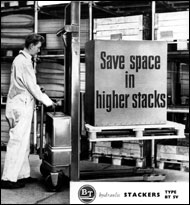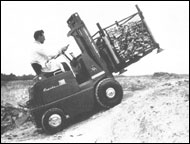 Fork truck news breaking around the world in late 1959 included Nichiyu of Japan building their first reach truck for launch in local markets. In Europe, due to an increase in export sales, BT Industries of Sweden launched two manual push pull electric stackers, models SV 05 and SV 10, built to lift 500 kg and 1000 kg respectively. In Britain, due to increased demand, the Matbro Company moved to larger premises in Horley, Surrey. The new factory was controlled under the direction of Leonard Mathews, leaving his brother Horace to manage their plant hire business at the Beddington Lane premises.
Fork truck news breaking around the world in late 1959 included Nichiyu of Japan building their first reach truck for launch in local markets. In Europe, due to an increase in export sales, BT Industries of Sweden launched two manual push pull electric stackers, models SV 05 and SV 10, built to lift 500 kg and 1000 kg respectively. In Britain, due to increased demand, the Matbro Company moved to larger premises in Horley, Surrey. The new factory was controlled under the direction of Leonard Mathews, leaving his brother Horace to manage their plant hire business at the Beddington Lane premises.
Completing the news for the year, Conveyancer Fork Trucks Ltd announced that they had taken over Scott Electric Vehicles Ltd of Kidderminster. The Scott Company had recently developed and introduced trucks fitted with the E.M.I. ‘Robotug’ electronic guidance control for driverless operation. British Rail was reported to be operating the system at one of its mainline depots, and at the remaining depots the system was in its final planning stages. E.M. Scott, Scott’s previous owner, continued to manage the company during the reorganisation process and subsequently stayed with the new company as a consultant.
The now renamed Conveyancer-Scott vehicles produced the ‘Robotug’ as the A.L.F. driverless truck. Exploratory routes for the machines were first laid out as cable or painted track on the surface of the floor, and when approved could then be embedded into the floor for a more permanent installation. The truck was guided by an AC current of predetermined frequency passed through the cable or track, which it picked up with two sensing coils attached to the front of the vehicle.
 After a year beset with industrial disputes that held up production in numerous sectors of the UK workplace, the New Year began with promising signs of a more settled situation in 1960. Many people in the materials handling industry were looking forward to its 7th Mechanical Handling Exhibition at Earls Court in London, and hoping it would help promote sales.
After a year beset with industrial disputes that held up production in numerous sectors of the UK workplace, the New Year began with promising signs of a more settled situation in 1960. Many people in the materials handling industry were looking forward to its 7th Mechanical Handling Exhibition at Earls Court in London, and hoping it would help promote sales.
Among the leading British manufacturers exhibiting at the show was Lansing Bagnall, with their first public showing of the FOER 5 (Rapide) sit-on rider-operated electric counterbalance forklift.
The picture here shows the machine on steep gradient trials, and adds support to the company’s claim that the machine was designed as a general service fork truck for operation in arduous conditions. Produced in two capacities, 2000 lb and 3000 lb, two of its main features were a fast road speed and a high rate of acceleration. This was partly made available by fitting the new Exide Ironclad Gauntlet battery, which was claimed to give 35% more power, in the same space, than any other Exide battery type. A new design for the chassis structure also gave a noticeable low centre of gravity to the truck and the consequential addition to stability. Included within this structural design was a new drive axle. An important feature here was that the wheel rim and brake hub on each side were formed into one single unit, thereby keeping the overall width of the machine down to a minimum.
By James Brindley, Director, National Fork Truck Heritage Centre
To be continued




Comments are closed.